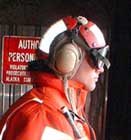 |
|
|
| Author |
Message |
Cammie
Guest

|
 Posted:
Thu Jun 17, 2004 2:51 pm Posted:
Thu Jun 17, 2004 2:51 pm |
  |
Hey, Craig!
Just wanted to ask what kinds of zooplankton you are seeing up there and what the relative abundance is. I saw the cool pic of the Calanus copepod. Are you doing much picking? Know that I am jealous!
I know that micozooplankton aren't your area of expertise, but is there anyone on board studying them? I saw one uzoop picture in the album, but couldn't tell what it was.
Have fun!
Cammie |
|
|
|
 |
Craig_Aumack

Joined: 20 Apr 2004
Posts: 9

|
 Posted:
Mon Jun 21, 2004 4:10 pm Posted:
Mon Jun 21, 2004 4:10 pm |
  |
Hey Cammie,
How is life in the Buskey lab this summer? I am sure that Christa will kill me when she finds out that I wrote you back promptly but haven't written her in awhile. What can I say, you question intregued me. Throughout the Bering and Chukchi Seas the following have been the major copepod species; Calanus glacialis, Calanus hyperboreus, Metridia longa (Ed would like M. longa because it is bioluminescent - a bright blue in fact), Pseudocalanus spp., Pareuchaeta glacialis, and Pareuchaeta novergica. We mainly see Pseudocalanus and C. glacialis over the shelf and C, hyperboreus and Pareuchaeta novergica over the basins. M. longa is primarily found in deeper water based on initial multi-net data. Based on population, Pseudocalanus is the most abundant copepod while C. glacialis is dominant based on biomass (about 4-5 x the size of Psuedocalanus). We also get a staggering number of arrow worms (Sagitta spp.), as well as various amphipods, jellies, and pteropods.
I do not have hard numbers for abundance since nobody actually does counts out here but I am personally picking bugs daily and sorting them by species. There are two other zooplankton labs conducting studies onboard; Sharon Smith's lab from Miami and Carin Ashjian's lab from MIT.
Say "Hi" to Becky and Christa for me.
Craig |
|
|
   |
 |
|
|
|
View next topic
View previous topic
You cannot post new topics in this forum
You cannot reply to topics in this forum
You cannot edit your posts in this forum
You cannot delete your posts in this forum
You cannot vote in polls in this forum
You cannot attach files in this forum
You can download files in this forum
|
Powered by phpBB 2.0.11
© 2001, 2002 phpBB Group :: FI Theme ::
All times are GMT
| |
